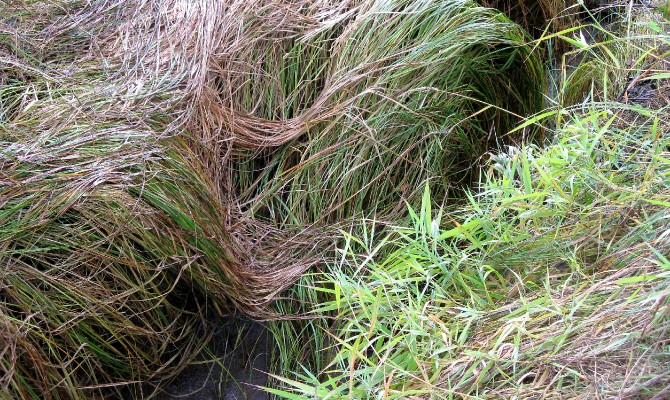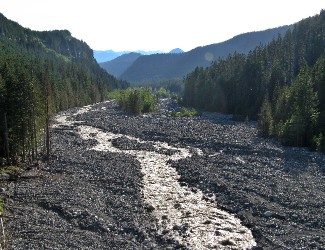NISQUALLY RIVER, Washington |
||
 |
||
Delta grasses in Puget Sound. |
||
————————————————————————————————— This essay was originally posted to National Geographic's Water Currents blog on August 1, 2016. ————————————————————————————————— Special thanks to Karissa Carlson, Lara Evans, Ann Friedman, Justin Hall, Lucia Harrison, Laura Lynn, John Montra, Marne McArdle, and Carmelle Olson. —————————————————————————————————
Birthed in Mount Rainier National Park, Washington from glacier melt on the southern slope of Mount Rainier, I flow seventy-eight miles into the Billy Frank Jr. Nisqually National Wildlife Refuge and on into Puget Sound, a fast and galloping ride from 14,000 feet down to sea level. I leave the glacier as melt water, with a milky cloudiness made from small particles of rock, minerals, and organic matter picked up and carried in my swift current. |
||
 |
||
Mt. Rainier (Tacobet in the Nisqually language) with tongue of Nisqually Glacier. |
||
These days, I only get to flow free for twenty-eight miles before being stopped by the first of two dams. I’m dancing along quite contently, when -- bam -- dam! I come to an abrupt stop behind a huge curved structure called the Alder Dam, with a height of 285 feet, and walls fifteen feet thick at the top and 120 feet thick at the base. Since 1945 I have been obliged to plunge down huge pipes, called penstocks, and turn two turbines inside a powerhouse to generate electricity. I am impounded (descriptive word for how I feel) for Tacoma Power hydroelectricity. My backed-up water forms a reservoir. I wish the people swimming and boating on my surface every summer would recognize how constipated and stagnant it feels to be a “popular recreational area.” |
||
 |
 |
|||
Frothy glacier-melt near the source. |
Alder Dam. |
|||
A few more miles downstream, I am plugged up again by Tacoma Power for additional electricity generation at the La Grande Dam, completed in 1912 and rebuilt in 1945. This dam, like all dams, causes a large back up of sediment that is no longer available to accumulate at the delta. So often, my needs and the needs of the people who use me as a “resource” are diametrically opposed. My natural functions are changed, permanently altering, and sometimes killing the ecosystems through which I flow.
I, naturally, would prefer to run free from mountain to sea. Hopefully, soon there will be alternative energy sources, but until then, these two dams provide power to more than 40,000 homes. To their credit, Tacoma Power does look after my water quality, fish, and some endangered species. They fund the Nisqually Tribe’s Clear Creek Hatchery, where millions of Chinook and coho smolts are raised every year. However, nobody asks me what I would want, which is to regain my rhythm and my range, and to bring back balance along my entire length.
There are many groups working on my behalf. The Nisqually River Council, founded in 1987, is a watershed protection framework for communities along my shore. The Nisqually Indian Tribe, for whom I am named, has been my close friend through many trials and tribulations. The Nisqually call themselves the “Susqually’absh,” which means “people of the grass” in Twalshootseed. One of my favorite places, located amongst old maples, fir, cedar, and dogwood trees, is called Frank’s Landing, named after Tribal Elder Willy Frank Sr. (born Qu-lash-qud). He and his son, Billy Frank, Jr. and their families have lived on these six acres since it was purchased in 1919. |
||
 |
 |
|||
Tribal sign depicting Mt. Rainier and the river. |
Paddles being carved by Nisqually Tribal members. |
|||
All through the 1960’s and 1970’s, the Tribe endured repeated harassment because the State of Washington began filing injunctions to curtail Indian fishing rights. As the Nisqually continued to practice their culture and feed their families, state law enforcement officials were continually arresting them. The Tribe would stage “fish-ins,” followed by arrests, convictions and jail time. Eventually, Billy Frank Jr. and others went to federal court.
Frank Jr. (whose Tribal name is Kluck-et-sah) was arrested more than fifty times in the struggle, but he kept his eye on the long run often bringing together former adversaries to preserve me and the fish. For a quarter of a century he headed the Northwest Indian Fish Commission, which brought a cooperative and consensus style of decision-making to watersheds in the Northwest. Their work often centered around the problems with dams, erosion caused by logging, and increased levels of fecal coliform from agricultural runoff.
Billy Frank, Jr. would eventually be presented with many honors, including the Albert Schweitzer Prize for Humanitarianism in 1992, and Indian Country Today’s First Visionary Award in 2004, but he once said what mattered most to him was an old shovel-nosed canoe, carved by his friend forty years ago, for which Billy paid fifteen salmon. On November 24, 2015, he was posthumously presented with one of the United States’ highest honors. One newspaper headline read, “Indigenous Hell-Raiser as National Hero: Billy Frank Jr. Wins Presidential Medal of Freedom.”
The Nisqually Tribes’ decades of legal battles lead to one of the most important Indian Laws ever passed. The Boldt Decision, known as the 1974 case United States v. Washington, affirms Nisqually off-reservation fishing rights. Overnight, Native Americans, who were one percent of the state population and had been limited to five percent of the fish harvest, now had the right to catch half of the state’s harvestable steelhead and salmon. Today, the Tribe works alongside Washington State as co-managers of fisheries, and they harvest in accordance with the treaties the U.S government had signed with the Tribes. This case was among the first to help decide an underlying question: To what extent do the Tribes, as separate nations within a nation, control their own destinies? State officials and nontribal fishers were outraged at this decision, and some even burned Judge Boldt’s image in effigy, but in 1979 the Supreme Court affirmed the ruling.
Eight years later, at the ripe age of 103, Willy Frank, Senior provided testimony about my historic importance to his tribe, a major factor in determining that I qualify as “a navigable river.” Salmon and steelhead were dying in the turbines of the two dams, and the Nisqually Tribe had sued the cities of Tacoma and Centralia, seeking damages and changes to federal licensing requirements. The Tribe won both lawsuits, and Frank Sr.’s testimony helped convince the judge that I am still vital to the Nisqually people. “Me and the river are the oldest things around here,” he said. “The river was here a long time before I came, and it’ll be here a long time after I’m gone.” |
||
 |
 |
|||
Fort Lewis warning sign. |
Unloading salmon. |
|||
Today you can see evidence of both nations along my shore. On one side the U.S. Army has occupied parts of the Nisqually Reservation since 1917 when it ordered Tribal members off the land and built Fort Lewis, America’s second largest military base, encompassing 60,000 acres, where both Colin Powell and Norman Schwartzkopf were commanding generals. Directly across on my other shore you may see a native fishing boat pull onto land, laden with freshly caught salmon, the ancestral lifeblood of the Nisqually Tribe. |
||
 |
 |
|||
Slug in delta region. |
Wa He Lut student looking at river bugs. |
|||
Elementary students from Wa He Lut Indian School gather small aquatic bugs and take them back to their classroom, which is nearby on my bank, where they look at the critters through microscopes. Faculty and students from The Evergreen State College come to my shore to study the riparian ecosystem. More than forty classes of teachers and students throughout the watershed monitor my water quality twice a year, sharing their results with our community, and making recommendations to keep the water healthy. Stream ecologists look for logjams, to see what life is hidden in the debris. Art students draw the grasses, banana slugs, herons, and wildlife.
As I stretch out into the Billy Frank Jr. Nisqually National Wildlife Refuge and enter Puget Sound about fifteen miles east of Olympia, Washington, my freshwater mixes with the saltwater of Puget Sound, forming a nutrient-and-wildlife-rich-estuary. In 2009, the Tribe worked closely with numerous groups including Ducks Unlimited, the National Wildlife Refuge System, U.S. Fish and Wildlife Service, and U.S. Geological Survey, on a large estuary restoration project here, which removed dikes, reconnected hundreds of tidal acres, and increased estuary delta habitat in South Puget Sound by more than fifty percent. It is a step in recovery, and is greatly appreciated by the threatened Chinook and steelhead, and everyone else who calls me home.
The Nisqually have lived beside me for at least 600 generations or 12,000 years. I am honored to witness their ceremonies and their commitment to me, the salmon, and the natural world. When the first salmon return to spawn, I hear drum beats across my water. Children coated in red ocher and bird-down gather with the elders at my edge to praise the fish spirits. The meat of the first salmon is cooked on skewers above open fire pits and shared with the whole community. Ceremonially, the fish skeleton is saved intact and given back to my body with its head pointing upstream to ensure the return of salmon year after year. |
||
next page: Amstel River >
< previous page: Great Miami River




































